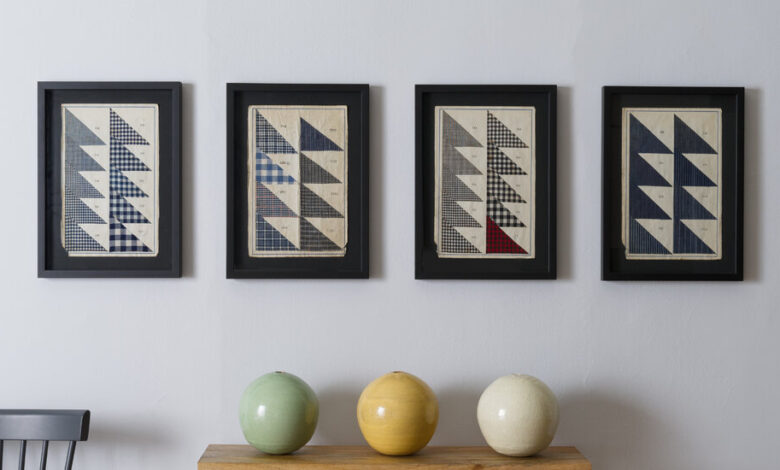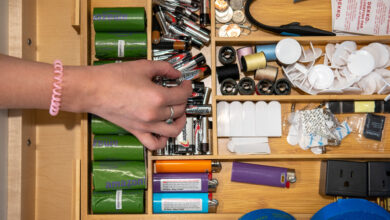The Stress-Free Way to Hang Art

Hanging art and other decorative items on the wall — one of the final steps in furnishing your home — should be fun. So why is it often a source of anxiety?
Maybe it’s because there are so many things to consider. How do you decide what to hang where? Which hardware should you use to keep heavy paintings — or, worse still, large mirrors — from crashing to the floor? If you make a mistake, will you damage the walls? And what if it all ends up looking wrong, somehow?
Not to worry: If you follow a few simple guidelines, decorating your walls isn’t difficult.
“The big thing to get over is the intimidation factor,” said David Kassel, the owner of ILevel, a professional art installation company in New York. “It’s not rocket science.”
And if you make a mistake, he added, “it can easily be changed” — with minimal damage to your walls.
Art installers and advisers recently shared a few of their secrets.
Choose What to Hang
If you have a large collection of art, figuring out where to place everything may seem so overwhelming that it’s hard to get started.
To make it feel more manageable, Berley Farber, the founder of Farber Art Services, a San Francisco-based installation company, recommended splitting things up into categories.
“If somebody has a hodgepodge of pieces, we would generally go through them and sort them into A’s, B’s and C’s,” Mr. Farber said, to ensure their favorite pieces get priority. “The A’s are the pieces we’re going to find a location for; the B’s we’ll be using to fill in gaps; and then the C’s may or may not make it up onto a wall,” depending on how the installation progresses.
Mr. Farber said he also likes to keep different types of pieces separate.
“Are they art, family or travel?” he asked. Family photos, he noted, usually look best clustered together, rather than interspersed among paintings and travel souvenirs.
If you have only a few pieces of art and are looking to expand your collection, online vendors like Saatchi Art, Lumas and Desenio make it easy to find more art in a hurry.
Decide Which Walls to Use
Not every wall needs to be covered with art. Often, less is more.
“I prefer not to hang something on every wall, but to play with identifying the key walls,” said Erica Samuels, the principal of Samuels Creative & Co., an art advisory firm in New York.
Consider where your eyes rest when you walk into the rooms you use the most, including the foyer, living room and primary bedroom. If you find you’re staring at a long, cold expanse of barren drywall, that’s usually an ideal place to hang a favorite artwork. A short wall that is sometimes obscured by an open door may not need anything.
Also think about how the scale of each piece will work in various rooms, because an outsize painting could easily overpower a small room.
“Size is really important,” said Monty Preston, the manager of curation and art advisory at Saatchi Art. “Find a space that gives the artwork enough room to breathe.”
Finally, think about sunlight, Ms. Preston said, as it can degrade artwork. For preservation, consider mounting favorite and valuable pieces away from windows that get lots of sun.
Place Individual Works
In general, art should hang at the eye level of an average-height person, with the center of the work about 60 inches off the floor, Mr. Kassel said: “That’s kind of a gallery approach.”
But few homes are as minimalist as galleries — there are fireplace mantels, moldings, window treatments and furnishings to consider, all of which can influence the height of the art, so there’s no strict rule.
In a room with exceptionally high or low ceilings, or one with decorative molding, for instance, you might want to hang art slightly higher or lower, to create a better sense of balance.
“It certainly helps to have somebody hold it up, so you can take a step back,” Mr. Kassel said, and make adjustments.
If you’re mounting a piece above a sofa or console table, Ms. Preston recommended leaving four to six inches of space between the top of the furniture and the bottom of the artwork. If you prefer a more casual look, she said, you could simply set the art on top of the console and lean it against the wall.
Widths matter, too. When you’re hanging art above a piece of furniture, both Ms. Preston and Mr. Farber recommended choosing a piece that is narrower than the furniture below it. “Having an artwork that’s about 75 percent of the width of a piece of furniture is a good rule of thumb,” Ms. Preston said.
Once you find the desired height, mark where the top of the piece meets the wall with painter’s tape, so you don’t lose track of the position. Ms. Samuels said she sometimes tapes out the full shape of the piece on the wall, to make sure that she’s happy with it, before hammering any nails.
Or Hang Multiple Pieces Together
When you’re hanging multiple works together — whether they’re in a row, a grid or a free-form gallery wall — there’s one thing that’s critical: the spacing between the pieces.
Most installers recommend arranging the art on the floor first, below the wall where you intend to install it, and creating a composition you find pleasing before transferring the arrangement to the wall.
The ideal spacing between frames “depends on the number of pieces of art and the size of the wall,” Mr. Farber said. “But it should generally be between one and a half and three inches.”
The vertical and horizontal spacing doesn’t necessarily have to be the same.
“If you’re hanging in a hallway, then the vertical distances should become shorter and the horizontal distances should become wider,” he said, to accentuate the length of the corridor. If the pieces are different shapes and sizes, you’ll have to accept some larger and smaller gaps.
One of Mr. Kassel’s favorite techniques for hanging works of different sizes together is to hang a row of pieces with the tops of the frames aligned at 59 inches from the floor. Then he hangs another row above, with the bottoms of frames aligned at 61 inches. That creates a clean, two-inch line of empty wall space between them.
“It gives it a cohesive, designed look where there’s a common element, and then this free-form aspect as well,” he said.
Use the Right Hardware
All the installers we spoke with recommended doing away with any picture wires and saw-toothed hangers on frames whenever possible, on all but the smallest pieces. Instead, hang each piece directly from two D-rings.
“If you want to have a nicely placed picture, flat on the wall, you have to remove the wire and replace it with two D-rings,” said Christopher Kopczynski, the owner of NYC Art Installation. The D-rings should be screwed into the back of the frame, about one-third of the way down from the top.
If you do that, Mr. Kopczynski said, “the picture will be straight on the wall, flat to the wall, and will not move.”
D-rings are available in various sizes and weight ratings, including strap hangers that attach with multiple screws, for heavier works.
But not all frames will accept D-rings, including some antique and metal frames, so it may be necessary to use some picture wires. In those cases, Mr. Kopczynski recommended putting mounting putty under the bottom corners of the frame, where they touch the wall, to keep the piece from shifting over time.
Some installers, like Mr. Kopczynski, like to hang each piece from two screws attached to the wall with drywall anchors. Others, like Mr. Kassel and Mr. Farber, prefer to use picture hooks from companies like OOK and Floreat, which are rated for various weights and leave only tiny holes if you need to remove them.
Because you’ll use two picture hooks for each piece, you can double the weight rating, Mr. Kassel said: “If you’re using two 30-pound hooks, you’re actually able to hang something that’s 60 pounds.”
When you hammer the picture hooks into the wall, he said, the more you can angle the nail downward, the more secure it will be.
Another good option for hanging heavier, longer pieces is to use a cleat made from two interlocking strips of metal or wood: One strip is attached to the back of the frame; the other is mounted to the wall with multiple screws. When you lift the work into place, the pieces lock together.
But whether you use screws with anchors, picture hooks or cleats, it’s best to avoid testing the advertised weight limits.
“If something is 60 pounds, I would still use two 50-pound hooks,” Mr. Kassel said. “It’s better to be stronger than not.”
For weekly email updates on residential real estate news, sign up here. Follow us on Twitter: @nytrealestate.






